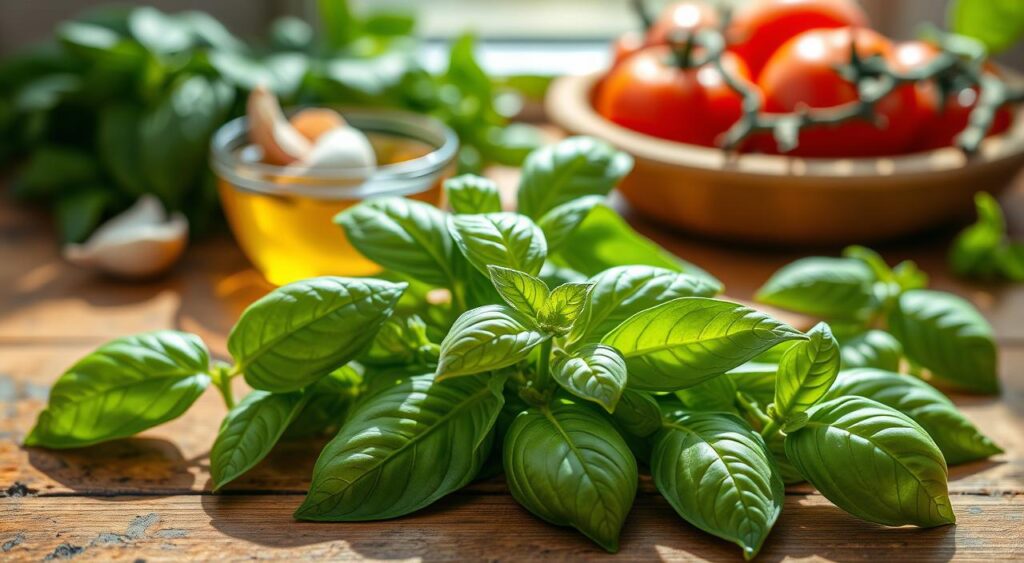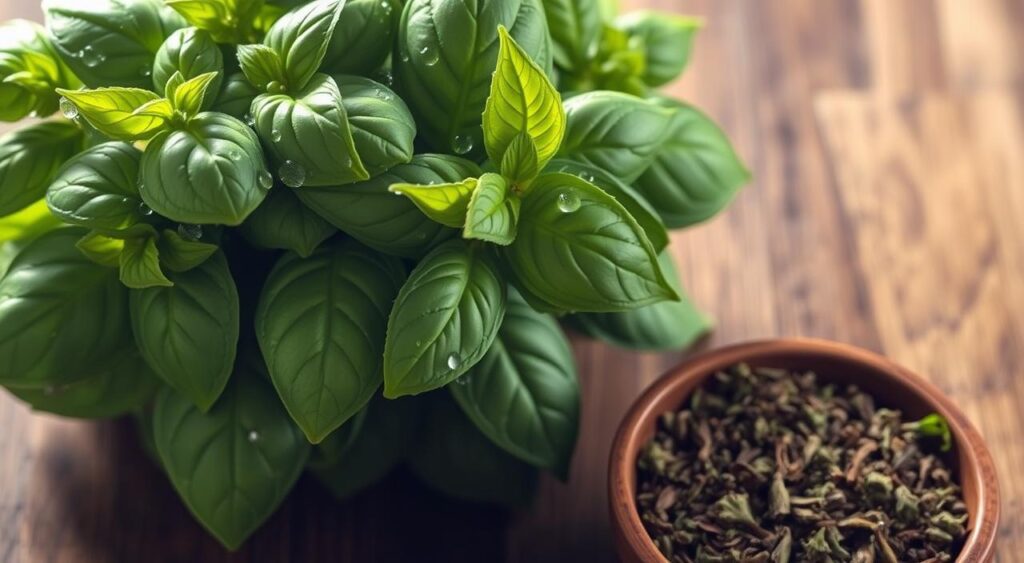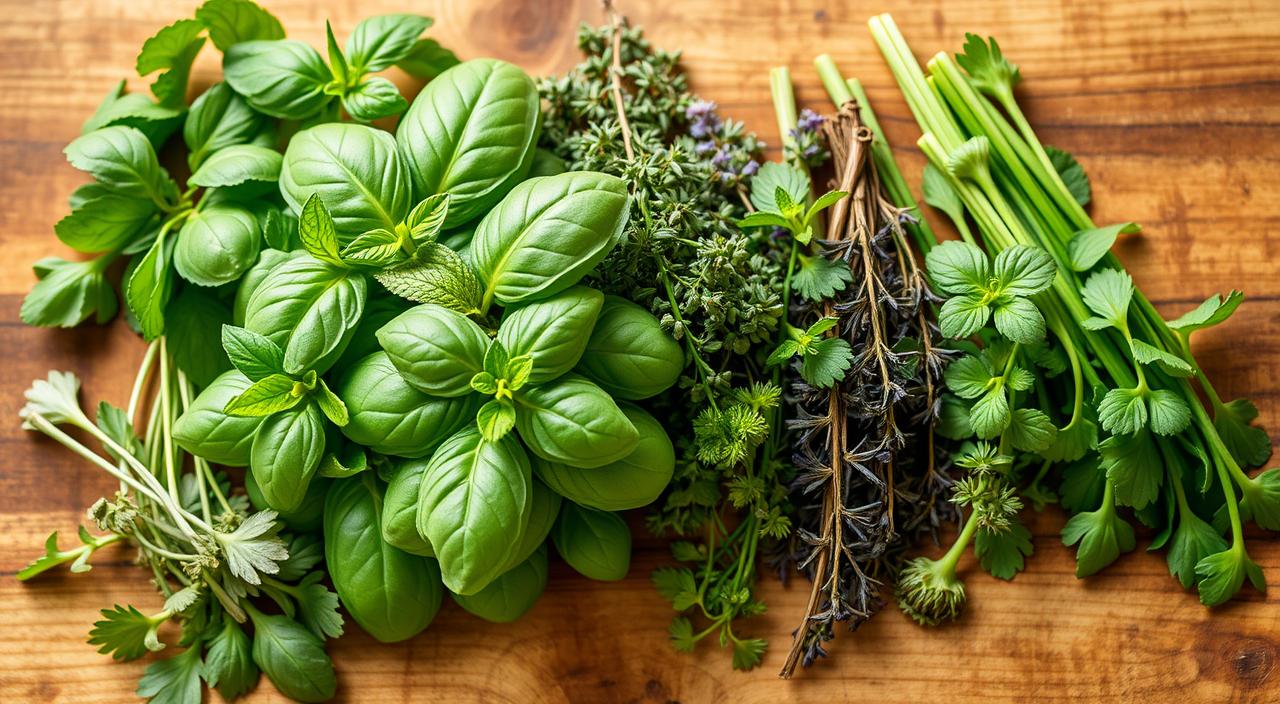As a passionate home cook, I know the frustration of running out of a key ingredient like basil. Whether you’re making a fragrant pesto or trying to replicate that perfect Caprese salad, the absence of fresh basil can be a real challenge. But fear not, my fellow culinary adventurers – there are plenty of flavorful basil substitute that can step in to save the day, ensuring your dishes still taste amazing.
Basil is a versatile and beloved herb, known for its subtle sweetness and herbaceous aroma. It’s a staple in Italian, Mediterranean, and Asian cuisines, adding depth and complexity to a wide range of dishes. But life happens, and sometimes our pantries and fridges don’t align with our culinary aspirations. That’s where a little creativity and knowledge of basil substitutes come in handy.
In this comprehensive guide, we’ll explore the best basil substitute options. We’ll cover the tried-and-true classics and the unexpected gems that can breathe new life into your recipes. Whether you’re whipping up a batch of homemade pesto, spicing up your favorite Italian dish, or experimenting with Asian-inspired flavors, you’ll have a wealth of alternatives at your fingertips. So, let’s dive in and discover the perfect basil stand-ins to elevate your culinary creations!
Understanding Basil: A Versatile Herb in Modern Cooking

Basil is a fragrant and versatile herb found in kitchens worldwide. It comes in over 60 varieties, with sweet basil being the most popular in Italian cooking. Thai basil, known for its anise-like taste, is also loved in Asian dishes.
Sweet vs Thai Basil: Key Differences
Sweet basil and Thai basil both have a unique taste. Sweet basil is mild, sweet, and slightly minty. Thai basil, on the other hand, has a stronger anise flavor. This makes it great for Thai and Vietnamese food.
Culinary Applications and Flavor Profile
Basil is not just for Italian food. It adds flavor to many dishes, from savory to sweet. It pairs well with tomatoes, cheese, and olive oil, making dishes like Caprese salad and Neapolitan pizza famous. It also goes well with other herbs like oregano and thyme, making it great for salad dressings and spice blends.
“Basil holds a significant place in the Italian kitchen, enhancing seafood and poultry dishes, red sauces, pizza, and pasta with vegetables.”
In modern cooking, basil is getting used in new ways. It’s even found in desserts and ice cream, showing its amazing versatility in the kitchen.
Fresh vs Dried Basil: Making the Right Choice

Choosing between fresh and dried basil can change how your food tastes. Fresh basil has a strong smell and a light taste. It’s best added towards the end of cooking. Dried basil, however, has a stronger taste and you need less of it.
Remember, one tablespoon of fresh basil is like one teaspoon of dried basil. When using dried basil instead of fresh, use less to get the same flavor. But, if you’re using fresh basil instead of dried, you might need more to get the right taste.
Fresh basil has more vitamins C and K than dried basil. But, dried basil is cheaper and lasts longer. Fresh basil is loved for its bright taste and smell, especially in salads, pizzas, and pesto.
Choosing between fresh and dried basil depends on what you like, the recipe, and what’s available. Both fresh and dried basil are good for you and can make your food taste better.
Top Fresh Basil Substitute Options
When a recipe asks for fresh basil, there are good alternatives. Oregano is the closest, with a similar earthy and peppery taste. Oregano is great as a basil replacement in dishes with Mediterranean or Italian flavors.
Spinach for Texture and Color
Spinach is a fresh alternative herb that looks and feels like basil. It’s milder but works well in pesto or stir-fries. Here, it adds color and texture without overpowering the taste.
Mint for Sweet Applications
Mint is perfect for sweet dishes where basil’s flavor might be too strong. Its bright color and texture make it a good choice for desserts and sauces.
“Basil substitutes can include Greek oregano, mint, thyme, tarragon, and savory.”
While no single ingredient perfectly matches basil, these alternative herbs are good options. They can help when your recipe needs fresh basil.
Best Dried Basil Alternatives for Cooking
When fresh basil isn’t around, you can use several dried basil substitutes. Dried oregano is a great match because it looks and tastes similar to dried basil. Tarragon adds a sweet and anise-like flavor, perfect for dishes that usually have basil.
is also a good choice. It’s a mix of herbs like basil and oregano. It can easily replace dried basil in many recipes. Remember, use one-third the amount of dried herbs as you would fresh herbs.
Finding the best dried basil substitute depends on your dish and taste. Try out these options to see which one suits your cooking best.
Italian Seasoning as a Basil Substitute
Italian seasoning is a great choice when you can’t find fresh basil. It’s a mix of dried basil, oregano, and other herbs. This blend is perfect for many Italian dishes.
Components and Flavor Balance
Italian seasoning’s success comes from its balanced taste. It has dried basil, oregano, and sometimes rosemary, thyme, and garlic. This mix gives a strong, comforting Italian flavor to your dishes.
Best Uses in Italian Cuisine
Italian seasoning is great in many Italian recipes. It’s perfect in tomato sauces like marinara or Bolognese. It adds a deep, savory taste.
It’s also good on pizzas, giving them an authentic Italian taste. Use it in baked pastas, chicken parmesan, and even in breads or focaccia for extra flavor.
When using Italian seasoning instead of basil, start with a little. Then, adjust to taste. This helps keep the flavor balance right in your dish.
Asian Cuisine Basil Substitutions
Basil is key in Asian dishes, especially Thai basil. It has a unique anise-like flavor. If you’re out of Thai basil, there are good substitutes.
Star anise is a great choice because of its strong anise taste. It might not have the same texture, but it adds a similar aroma and flavor. If star anise is not available, sweet basil or holy basil can also work. They don’t have Thai basil’s anise note, though.
Cilantro is another good substitute for basil in Asian dishes. It has a bright, citrusy, and slightly peppery taste. It’s great in soups or curries. You might need to use more of it than regular basil because of its stronger flavor.
“Experimenting with different basil substitutes can be a fun way to explore new flavor profiles in your Asian-inspired dishes.”
When substituting basil, think about the dish’s flavor and adjust the amount. Try different Thai basil substitute or basil alternatives to find the best one for your dishes.
Herb Combinations to Replace Basil in Pesto
Basil is the usual star in pesto. But, you might want to try basil substitute options or pesto alternatives for different reasons. Maybe you want to try new tastes or follow a special diet. There are many green options that can make tasty pesto.
Green Alternatives for Traditional Pesto
Spinach, kale, arugula, parsley, cilantro, and mint can replace basil in pesto. These greens and herbs bring unique flavors. For example, arugula adds a peppery taste, while cilantro has a zesty flavor.
For heartier greens like spinach or kale, mix them with lighter herbs. This keeps the taste balanced.
Maintaining Proper Ratios
When you swap basil with other greens, watch the ratios. Pesto usually has a 2:1 basil-to-other-ingredients ratio. Use a similar amount of your pesto alternatives to keep the flavors right.
Adjust the garlic, cheese, and nuts as you like. This helps the new herb mix work well together.
“Pesto is a versatile sauce that can be adapted to suit your personal preferences and the ingredients you have on hand. Don’t be afraid to experiment with different green combinations to find your new favorite pesto recipe.”
Looking to use less basil or try new tastes? These basil substitute options can refresh your pesto. A bit of experimentation can lead to amazing herb mixes that elevate your pesto.
Cooking Tips When Using Basil Substitutes
Basil is a versatile herb that adds depth to many dishes. But what if fresh basil isn’t available? There are several good substitutes you can use. Here are some tips to keep your dishes tasting great.
When adding a substitute herb, timing is key. Dried herbs like oregano or thyme should go in early. This lets their flavors blend well with the dish. Fresh herbs like mint or spinach should be added later. This helps keep their taste and smell fresh.
Think about the flavor strength of the substitute herb. Start with a small amount and add more as needed. For example, Thai basil has a strong anise flavor. You might need less of it to avoid overpowering your dish.
“For dishes where basil is a key ingredient, such as Caprese salad or bruschetta, consider using a combination of herbs to mimic basil’s complex flavor profile.”
By following these cooking tips when using basil substitutes, your dishes will still taste great. Even when fresh basil isn’t available.
Measurement Conversions for Herb Substitutions
Herbs are key to a dish’s flavor. But what if you’re missing the herb a recipe asks for? Don’t worry, you can easily swap herbs with the right measurements.
For most cases, use one-third the amount of dried herbs as fresh. So, 1 tablespoon of fresh basil can be replaced with 1 teaspoon of dried basil. This rule works for many dried herbs.
But, some herbs need different amounts. Ground herbs like ginger or onion powder require even less. Use 1/4 teaspoon of ground ginger for every 1 teaspoon of fresh ginger. Dried bay leaves are stronger, so use half as much as fresh.
When swapping fresh herbs for dried, you’ll need more fresh. Use 3 times as much fresh as dried. For example, 1 teaspoon of dried oregano can be replaced with 1 tablespoon of fresh oregano.
“Proper herb substitution can be a delicate balance, but these measurement conversions take the guesswork out of the equation.”
Knowing these herb substitutes and measurement conversions will make your cooking better. With a bit of practice, you’ll master swapping herbs in no time!
Conclusion
Basil is special in cooking, but you can still make great dishes without it. You can use oregano, spinach, or mint as basil substitute options. These herbs offer different tastes that can enhance your recipes.
Knowing how to use these substitutes is key. It helps keep your dishes tasting just right. Whether you’re making Italian food, Asian dishes, or pesto, these alternatives will help you succeed.
Learning about these substitutes makes you a more flexible cook. You can create tasty meals even when basil is not available. This shows off your cooking skills and ensures delicious results.
FAQ
What are the best substitutes for fresh basil?
Good alternatives to fresh basil include oregano, spinach, mint, cilantro, tarragon, and savory. These herbs can match fresh basil’s texture, taste, and color in different dishes.
Can dried basil be used as a substitute for fresh basil?
Yes, dried basil works as a substitute for fresh basil. Just remember to use less of it. A good rule of thumb is to use one teaspoon of dried basil for every tablespoon of fresh basil in a recipe.
What is the best substitute for Thai basil?
Star anise is a great substitute for Thai basil because of its strong anise flavor. Sweet basil or holy basil can also work, but they don’t have Thai basil’s unique anise taste.
Can I use Italian seasoning as a substitute for basil?
Yes, Italian seasoning is a good substitute for basil in many recipes. It usually has a mix of dried herbs like basil, oregano, and spices. This makes it perfect for Italian dishes.
How can I substitute basil in pesto?
You can use spinach, kale, arugula, parsley, cilantro, or mint as basil substitutes in pesto. These greens and herbs can be used alone or together to replicate the taste and texture of traditional basil pesto.
When should I add dried herbs versus fresh herbs as a basil substitute?
Add dried herbs early in cooking, while fresh herbs are best added later. This way, dried herbs can fully develop their flavors. Fresh herbs will keep their bright taste and aroma.
